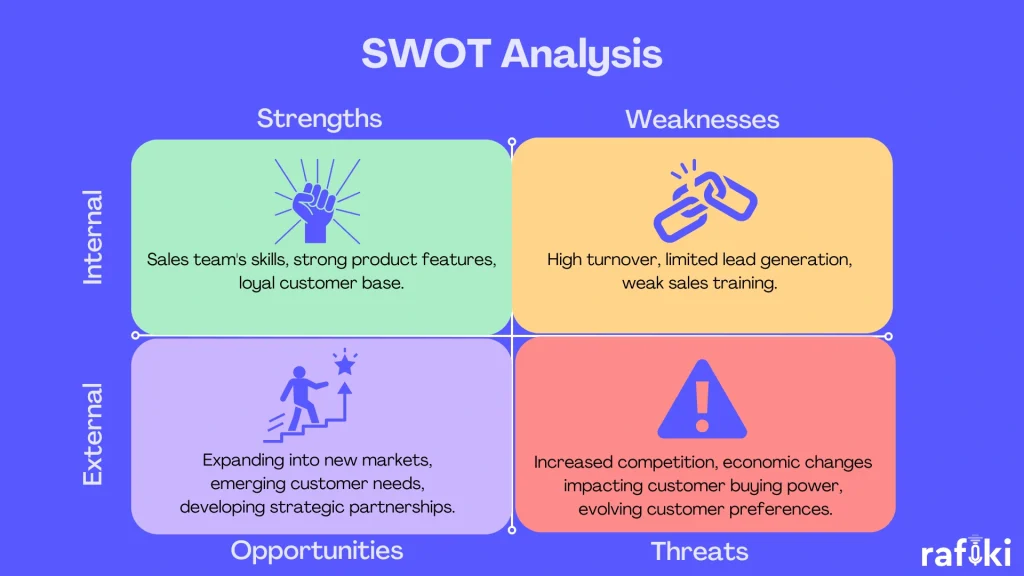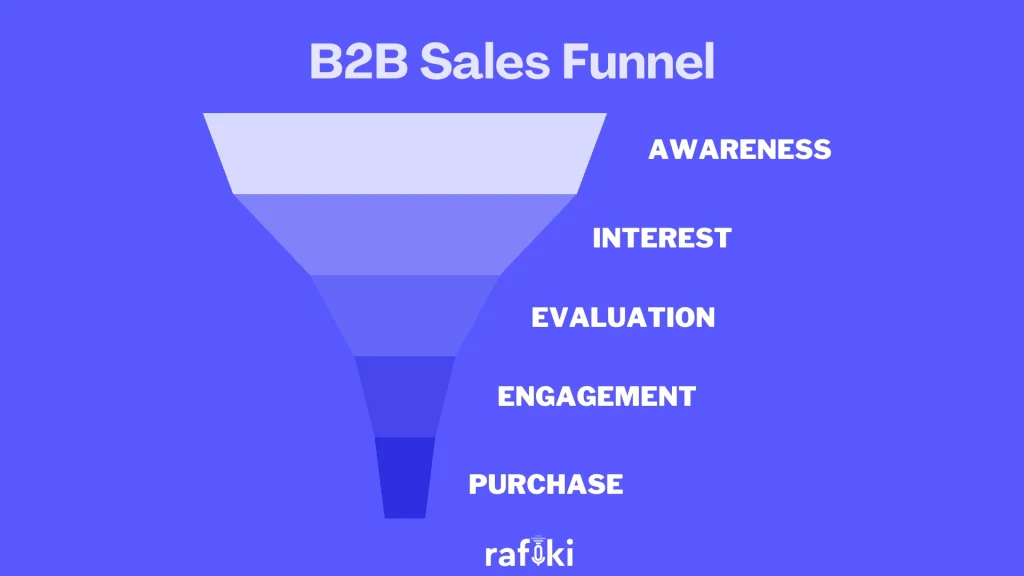Why Rafiki
Pricing


Pricing
Solutions

RevOps Leaders
Synchronize revenue generating functions

SDR Leaders
Get your team aligned and Coach your Reps 3x faster at scale

Sales Leaders
Unlock pipeline truth, drive confident forecasts

Feeling the pressure to hit those ambitious sales targets? You're not alone. The field of Sales is brutal. Especially with the current state of the market in 2024 where everyone is trying to cut costs and taking far too long to weigh their options. Now, crafting a solid sales plan is not optional, it's essential. A well-defined sales planning process acts as a roadmap, guiding your sales team towards achieving success. It helps you set realistic goals, identify your ideal customers, and develop winning strategies to close more deals.
So, how do you get started with sales planning?
Let's dive in and explore the key steps involved in creating an effective sales plan that gets results.
Sales planning is a strategic process that sets the foundation for your entire sales operation. In essence, it's about taking a step back to gain clarity on your goals and charting a course to achieve them.
Think of it like planning a road trip. You wouldn't just hop in the car and start driving, hoping to stumble upon your destination by chance, right? Sales planning works the same way. It involves analyzing your current sales performance, identifying your target market, and then meticulously crafting a strategy to reach and convert those ideal customers.
This strategic approach ensures your sales team is laser-focused on the right activities. It eliminates wasted effort and keeps everyone aligned towards achieving the sales plan's objectives. By investing time upfront in sales planning, you'll empower your sales reps to become high-performing revenue generators.
Now that we understand the importance of sales planning, let's delve into the steps involved in creating a winning plan. Here's a breakdown of the core phases:
Every successful sales plan starts with a thorough understanding of your current landscape. This involves gathering data and analyzing your sales performance over the past period. Key metrics to examine include sales figures, win rates, conversion rates at different stages of the sales funnel, and customer lifetime value. By analyzing these metrics, you can identify trends, pinpoint areas for improvement, and assess the strengths and weaknesses of your current sales approach.
For example, if you see a consistent drop in conversions after product demos, it might indicate a need to improve your demo strategy or address common objections raised by prospects during that stage. Sales planning software like Anaplan can help automate data collection and analysis, saving your team valuable time and resources. You could also conduct a SWOT analysis to get the lay of the land.

Vague aspirations like "increase sales by 15%" won't get you very far. Effective sales planning requires setting Specific, Measurable, Achievable, Relevant, and Time-bound (SMART) goals. SMART goals provide a clear roadmap for your sales team, ensuring everyone is working towards the same objectives.

Here's what each element of a SMART goal entails:
For example, a SMART goal could be "achieve a 20% increase in qualified leads generated through inbound marketing channels within the next quarter."
Not everyone is your ideal customer. Effective sales planning involves pinpointing the specific audience most likely to benefit from your product or service. This targeted approach allows you to focus your resources and craft messaging that resonates with your ideal customers' needs and pain points. To identify your target market, you'll need to conduct market research and create a detailed ideal customer profile and/or buyer persona.
An ideal customer profile (ICP), usually used in B2B, comprises the details of your perfect customer. For example, it could be all financial services companies in New York having 500-5000 employee size and an annual revenue of $10+ million. A buyer persona, on the other hand, is a semi-fictional representation of the people that either work in your ICP (if you’re in B2B) or the best consumers to sell to (if you’re in B2C). It outlines their demographics, firmographics (company-based characteristics), challenges, goals, and preferred communication channels. By understanding your target market intimately, you can tailor your sales strategy and messaging to resonate with their specific needs.
For example, an accounting software company might target small and medium-sized businesses (SMBs) in the professional services industry. Their research on ICP might reveal that these SMBs are typically frustrated with manual bookkeeping processes and struggling to keep up with changing tax regulations. This information would then inform the development of marketing materials and sales pitches that address these specific pain points.
With a clear understanding of your goals and target market, it's time to craft the strategies and tactics that will fuel your sales efforts. This involves outlining the overall approach you'll take to reach and convert prospects. Here, you'll need to decide on the types of sales channels you'll utilize (e.g., outbound prospecting via email and/or calls, social selling, events etc.).
Furthermore, define specific tactics for each stage of the sales funnel. This could include lead generation activities, qualification criteria, content creation strategies for nurturing leads, and objection handling techniques for closing deals.

For instance, a B2B software company targeting enterprise clients might focus on building strong relationships with key decision-makers through account-based sales initiatives. Their sales tactics might involve personalized email outreach, in-depth product demos tailored to specific business needs, and free trials to showcase the software's value proposition.
A sales plan is a roadmap for action. This step involves translating your strategies and tactics into a concrete action plan that your sales team can execute. Break down your sales activities into manageable tasks with clear deadlines and assign ownership to specific team members.
Here, it's crucial to incorporate training and enablement initiatives to ensure your sales reps possess the necessary skills and knowledge to execute the plan effectively. Sales planning tools can be valuable assets in this stage, allowing you to create visual sales pipelines, track task completion, and monitor individual and team performance.
For example, an action plan might include weekly sales meetings to discuss progress, ongoing sales coaching sessions for reps, and deadlines for completing specific tasks like qualifying leads or sending follow-up emails.
Sales is constantly evolving. An effective sales plan shouldn't be a static document. Regular monitoring and adaptation are essential for ensuring your plan remains relevant and drives results. Establish key performance indicators (KPIs) to track progress towards your goals. These KPIs could include metrics like lead generation rate, conversion rate at each stage of the funnel, and sales cycle length.
For instance, if you see a decline in lead quality, you might need to refine your qualification criteria or improve your lead generation efforts.
Rafiki's Smart Call Scoring can be a game-changer in this step. It objectively analyzes sales calls, identifying areas for improvement and highlighting top performers. This allows sales managers to focus coaching efforts strategically and helps reps elevate their communication skills for better results. Keep in mind, a dynamic sales plan that adapts to changing circumstances is key to achieving long-term success.

Crafting a watertight sales plan is crucial, but the work doesn't stop there. Here are 6 actionable tips to elevate your sales plan and take it from good to great:
Gone are the days of relying solely on spreadsheets for sales planning. A suite of sales planning tools can now empower you to streamline the process and gain valuable insights. Here's a tech toolbox to consider:
A well-defined sales plan is the cornerstone of a thriving sales organization. From research to crafting a plan and getting your team to adopt the plan effectively, every step is both a chance to make a mistake or an opportunity to take your org to the next level. Craft a plan that propels your sales team towards achieving remarkable results.
Keep in mind, an effective sales plan requires continuous monitoring and adaptation. Rafiki can be your secret weapon in this process. The platform’s conversation intelligence features provide valuable insights to optimize your sales strategy and elevate your team's performance.
Ready to see how Rafiki can help you take your sales planning to the next level? Sign up for your free 14-day trial today and unlock the power of data-driven sales success!
Optimize Your Sales Plan with Insights